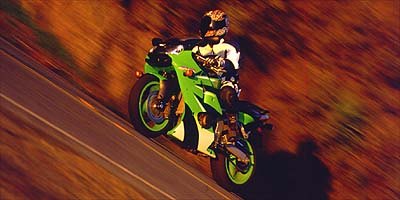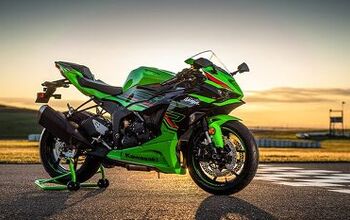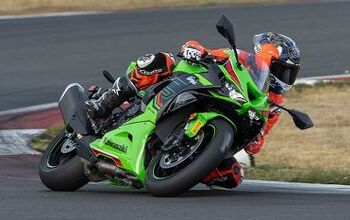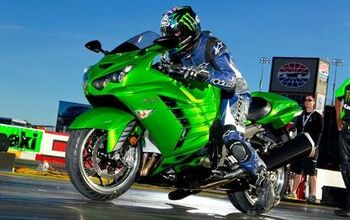First Ride: Year 2000 Kawasaki ZX-6R

Los Angeles, March 6, 2000 -- It's no surprise that 600cc Supersport motorcycles have been the best-selling class of sport bikes for the past few years.
Although their larger displacement brethren make more power, the 600s, with their lighter weight and smaller stature, offer greater rider confidence while producing almost 100 horsepower at the rear wheel, proving that size doesn't always matter.
The 600cc Supersport bike class is among the most competitive, both at the track and on showroom floors. Over the last few years all four Japanese OEMs have significantly redesigned their 600cc SS models.
Kawasaki fired the first shot in 1998 with an all-new ZX-6R and after Yamaha and Honda introduced all-new models in '99, and they further refined the 6R in 1999 to keep pace.
For the 2000 model year, only Kawasaki has tinkered with their 600 Supersport, giving the 6R a new engine, totally revised suspension and a completely new look. Kawasaki insists the Year 2000 ZX-6R is the bike to own in the 600 SS class and they've given us one to see if we concur. Do we? Well ...
Tech Verbiage
The ZX-6R's all-new 599cc power plant received the most attention of any major component. It has an aluminum cylinder block that now features liner-less, electroplated bores (same as the ZX-9R) which are reported to save weight as well as improve heat dissipation. The cylinders themselves have a redesigned "pentroof" combustion chamber that features an increase in compression from 11.8:1 to 12.8:1 the result of which requires the use of at least 90-octane fuel.
New cylinder-head valves feature stronger stems, and the tops of the valve tappets are slightly crowned to increase tappet and cam lobe durability. The carb holders are 7.7mm shorter to increase top-end power. The valve springs are wound on a smaller radius to reduce the inner diameter of the coil for finer valve action control at high rpm.
The water pump has a new, more durable seal. The connecting rods are stronger for better reliability at upper revs. The ignition system has a new central processing unit for quicker response to engine needs. The rotor has three times as many projections (increased from 4 to 12 projections), helping to update the processor more often. The processor itself has been upgraded from 8 bits to 16 bits. The all-new ignition timing map matches the other engine changes. New stick-type ignition coils draw less current and charge faster to aid starting. The clutch cover, head cover, oil pump cover and sump pan are now magnesium instead of aluminum, saving weight. Cam sprockets are thinner to reduce weight as well.
"The swing-arm is all-new with extruded aluminum beams and no rubber dampers inside, reducing the weight by nearly one pound."
While the exhaust exits out of a new 4-2-1 exhaust system, the air enters the engine through a new, twin ram-air system featuring larger ducts for more pressure and increasing high-speed power. Extended openings in the system help keep overall air inlet pressure high. A new alternator has higher-output, rare-earth neodymium magnets while being lighter and smaller for quick throttle response. Intake snouts adorn the front of the 6R to increase power at racetrack speeds and the new aerodynamic bodywork is "swoopier" to reduce the drag-coefficient.
The swing-arm is all-new with extruded aluminum beams and no rubber dampers inside, reducing the weight by nearly one pound. Noise is damped by internal ribs in the beam extrusion. The overall cross-section of the swing arm is hexagonal. Front and rear axles are 25mm in diameter (nearly one-inch) for better strength and rigidity as well as being hollow to reduce weight. The rear caliper mounts directly to the swing-arm to reduce the weight.
Slightly revised, stiffer front fork suspension settings have been incorporated to improve performance on the track and street. The rear shock has 20-way compression and rebound damping while the Uni-Trak rear suspension gets a new linkage for a more linear response. The brake calipers have different sized pistons (the '99 ZX-6R had six pistons measuring 27mm, the Y2K edition has four at 27 and two at 24mm) in their six-piston calipers. New pad material has also been added for increased friction.
The California models receive an evap' can (which adds 3.5-pounds) and a full-bodied catalyst as opposed to the diffuser found on 49-state models. The catalyst causes a 1.5-to-2.0 horsepower loss from the 49-state version. Thankfully, the can and related hoses can be removed easily enough and an after-market exhaust gets rid of the catalyst.
The suspension settings have been changed to match the stiffer chassis. Similar to the ZX-9R, the rear shock now has a ride height adjuster to match the new damping characteristics. The front end received complimentary damping changes as well. Thanks to all of its dietary modifications, the ZX-6R's weight has been reduced to a claimed dry weight of 380 pounds.
The MO Translator: Deciphering OEM ClaimsWhen an OEM says they have a new and improved sport bike, what they usually mean is that they have made changes that sharpen (stiffen) the suspension and improve the motor (make more powerful). This gives the manufacturer bragging rights about who has the best (fastest) bike on the track, even though 95 percent of bikes sold will never see a real road course.
Often, what this means for the average consumer is that they now have to live with a bike that costs few hundred dollars more and is less comfortable and less practical for everyday use. Hey, but at least it has a more impressive dyno chart.
"We took a new Ducati 748 along for as a reference bike and there was really no place on the street where the Kawasaki rider couldn't open the throttle and close in on the Ducati."
Before we even swung a leg over Kawasaki's new ZX-6R, we feared that we were going to sit on a bike that was closer to a race bike and farther away from anything we could really use. We are not always wrong, but in this instance, we're glad we were.
The first thing that surprised us about the new 6R is how comfortable the ergonomics were. Where a GSX-R600, for instance, takes its racetrack-breeding straight to the street, Kawasaki understands that fitting a comfortable set of clip-ons does not negate all the hard work done to get the bike's performance numbers to the top of the heap. This bike will blitz down any road you point it down and do so with impressive comfort.
The wind protection and ergos on the 6R are surprisingly good; some testers even likened it to the Yamaha YZF-600 that we tested a few months ago. The riding position is still sporty but upright enough so that you don't feel like a contortionist, and the seat-to-foot peg distance feels slightly longer and more relaxed, particularly for a 600 SS-class motorcycle.
While we didn't ride the ZX-6R to a racetrack due to limited seat time, we were able to flog it up and down a few of our favorite back roads to discover that, despite all the comfort, this bike is no slouch when it comes to performance. The motor is something that Kawasaki seems to be most proud of; they're known for having made some of the best power plants in recent years, and this 6R is no exception. It's deceptively fast.
The motor is extremely smooth, both in terms of vibration and in the way it makes power. Where previous 600s have been known to buzz their way through higher rpm, the ZX-6R is very smooth and refined. And where many 600s lack any sort of bottom-end power and rely solely on a hard-hitting, mid-to-top-end surge, the ZX-6R, to it's credit, is devoid of any significant jolt. The power is noticeably stronger at 9000 rpm, but because it doesn't really lag in the lower-end, there's a wonderful feeling of smoothness.
Don't fret ZX-philes, smoothness doesn't have to translate into slow, and this motor, by all accounts, is not. We took a new Ducati 748 along for as a reference bike and there was really no place on the street where the Kawasaki rider couldn't open the throttle and close in on the Ducati. The 748 is no slouch, but the ZX-6R just plain hauls. Even coming off the turns where the 6R pilot would expect the V-Twin to have the edge on corner exits, as long as the revs were kept above 8000, the 6R had no problem keeping the 748 in sight, and down the straights it was trouble for the twin.
"Hard on the throttle and over rough rises, the ZX-6R did occasionally twitch its head."
Because it also seemed prone to wallow a bit in the turns, we increased the pre-load on the rear shock by a few turns (to put more weight on the stiff front end) as well as adjusting the compression damping by four clicks and the rebound damping by two. With those minor changes, the front end had more weight on it and felt more planted and stable, providing the rider with the feedback needed to maintain high cornering speeds. It also kept the back end of the bike from bobbing and weaving in the turns over rough pavement or during on/off throttle transitions.
Year 2000 Kawasaki Sport Bikes 1999 600cc Supersport Shootout First Ride: 2000 Kawasaki ZX-9R Kawasaki has always fitted their bikes with powerful brakes even if their feel was a bit wooden. Like the new ZX-9R, the ZX-6R's new brakes are fantastic. They have excellent initial bite and the harder you pull on the lever, the quicker you stop. The only quirk with the entire brake system was that a few of our larger-pawed test riders found the front brake lever to be narrower than they would have preferred. However we noticed this only under hard braking situations where a great deal of lever pressure was being applied.
The Final Word
Perhaps you have noticed that we have referred to the ZX-9R a few times in this story. It's because both bikes are so similar. In fact, take a quick peek in the cockpit of either bike and you may not be able to tell the difference. The ZX-6R is noticeably smaller, but still it seemed to retain the 9R's stability and power. We were extremely impressed with the new ZX-6R in the little time we spent on it. It seems to have has a great deal of racetrack prowess without sacrificing too much for street use.
Kawasaki enters 2000 with the most significantly-changed motorcycle in the 600 SS class. They expect the ZX-6R to sell so well that they are importing 60-percent more bikes this year. From what we can tell there is no reason why it shouldn't sell, and we're looking forward to dishing out even more strenuous tests on this new Kawasaki both on the street and track.

Motorcycle.com presents an unrivaled combination of bike reviews and news written by industry experts
More by Motorcycle.com Staff

































Comments
Join the conversation